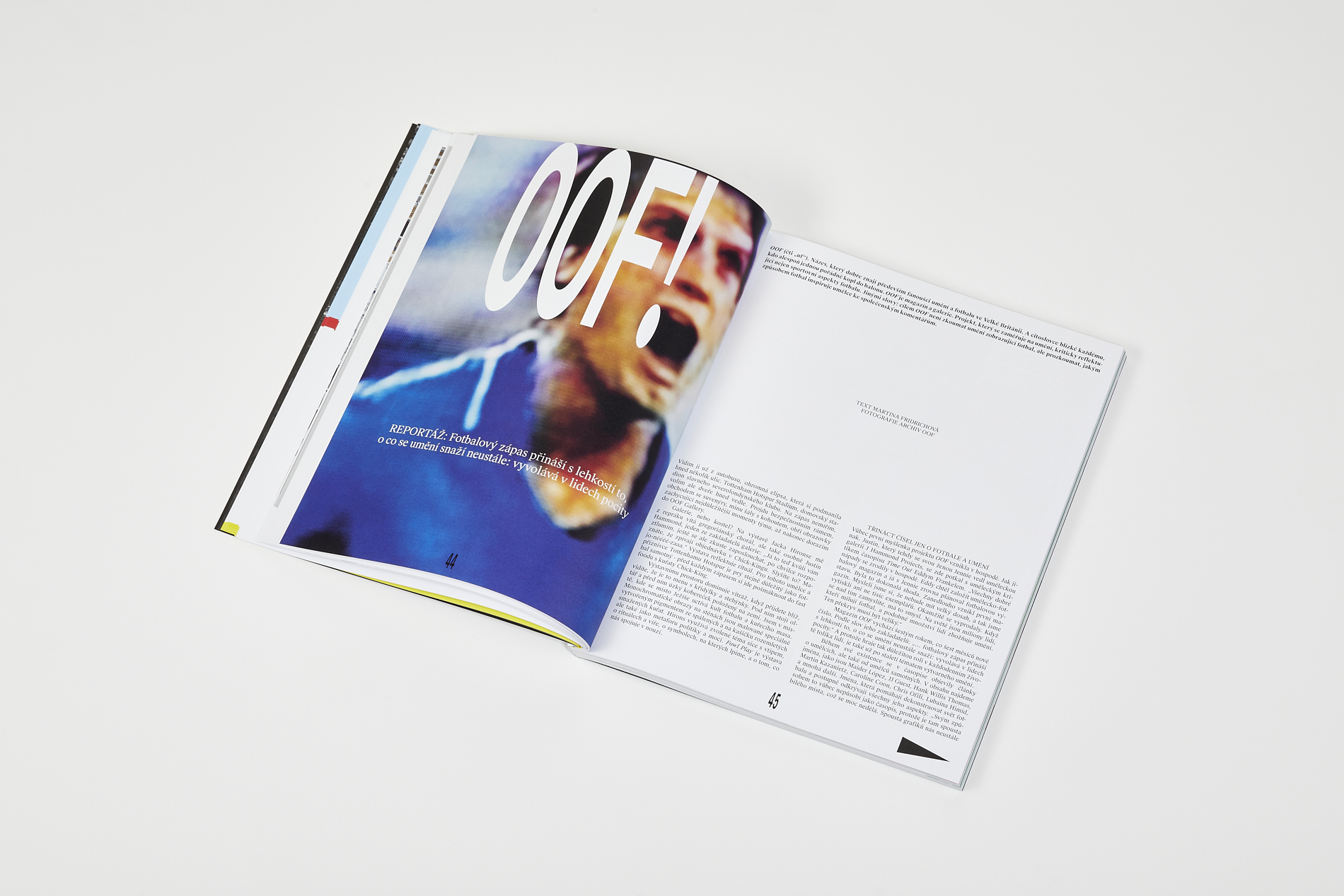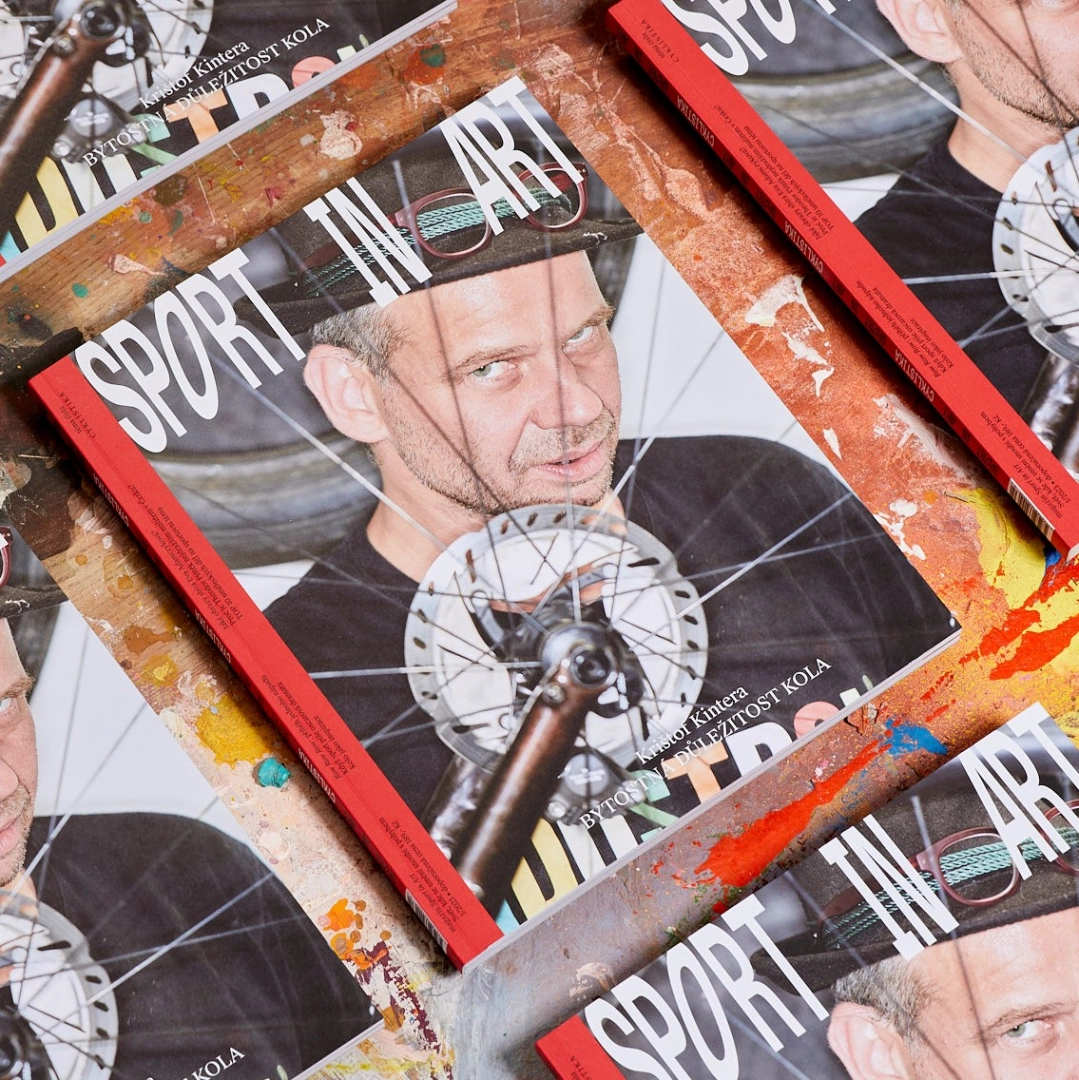OOF. A name well-known primarily to fans of art and football in Great Britain. An onomatopoeic expression that resonates with anyone who's ever kicked a ball properly. OOF is both a magazine and a gallery—a project singularly dedicated to art inspired by football. But it's more than that; it primarily mediates art that critically examines all aspects of football, not just the athletic ones. Its aim isn't to explore art depicting football but to delve into how artists employ football to comment on society.

TEXT: MARTINA FRIDRICHOVÁ
PHOTOS: OOF ARCHIVE
I spotted it from the bus already, a massive ellipse that has conquered several streets of North London - the Tottenham Hotspur Stadium, home ground of the English football club Tottenham Hotspur. Although I'm not heading to the match, I opt for the door right next to it. First, I pass through security measures, then I'm allowed into the souvenir fan shop, I proceed past scarves with a rooster emblem, football boots, I pass giant screens capturing the team's most crucial moments until I arrive at the OOF gallery.
.jpg)
Gallery or church? In Jack Hiron's exhibition, I'm welcomed by Gregorian chant through the speakers, but also personally by Justin Hammond, one of the gallery's founders: "I'll lower it now for you, but try to listen closely, after a while, you'll recognize that they're singing the word mayonnaise. Can you hear it? Ma-yo-néééé-zaaa." The exhibition reflects ritual. For the artist and Tottenham Hotspur fans, it's allegedly as important as football itself - before every match, they go to indulge in Chick-King chicken fast food.
„
We love football, but we're aware that it's also quite messed up. It's violent, racist, sexist, homophobic. But you know what? All these bad things make for good art.
The exhibition space is dominated by a stained glass window, as you come closer, you see it's a menu with wings and thighs. Below it, an altar and a narrow carpet winding through the space. I'm in a place where instead of Jesus, the cult of football and chicken is worshipped. The monochromatic paintings on the walls are painted with a specially created pigment from burned and finely ground fried chickens. Hirons uses the chosen theme with humor, but also as a metaphor for politics and power. Fowl Play is an exhibition about rituals and faith, about symbols we cling to, and what connects us in times of need.
.jpg)
ALREADY 13 ISSUES SOLELY ABOUT FOOTBALL AND ART
The very first idea for the OOF project came about in a rather unsurprising place - after a Tottenham match. Justin, who at the time ran an art gallery, J Hammond, with his wife Jenny, happened to meet the art critic of Timeout magazine, Eddy Frankel, in a local pub. "All good ideas are born in a pub. Eddy wanted to start an art-football magazine, and I was just planning a football exhibition with Jenny. It was a perfect match," he recounts with a twinkle in his eye, adding, "Soon after, the first magazine was born. We thought no one would be interested, so we only made a thousand copies. They sold out immediately. When you think about it, it makes sense. There are countless millions of people in the world who love football and a similar number who adore art. And among them is precisely that intersection, those who are interested in both."
.jpg)
Already in its sixth year, the OOF magazine has been published every six months. According to its founders: "Every day, football does with ease what art constantly tries to do: it makes people feel." And because it plays such a significant role in the daily lives of so many people, it has also been a theme in visual art for centuries.
Throughout its existence, the magazine has featured articles about artists, but also contributions from artists themselves. In its content, you'll find names like Maider López, JJ Guest, Hank Willis Thomas, Martin Kazanietz, Caroline Coon, Chris Ofili, Lubaina Himid, and many others. These are names that help deconstruct the world of football and gradually reveal all its aspects.
.jpg)
"In a way, it doesn't feel like a magazine at all because there's a lot of white space, which isn't typical for magazines. Many graphic designers contact us constantly and ask if they could design our magazine because we don't do it very well. And we say: we know it's not exactly a magazine, but that's what makes it great. It has the same dimensions as the old football program White Hotline Pitch. The funny thing is that probably no reader of the magazine ever realized it, and we pay much more money for this specific format," Justin adds with a laugh. Meanwhile, he introduces me to the individual issues that have already been published until he stops at one: "The content is the same in each of them. We just made four different covers. They are key moments in the history of the World Cup. For example, this is a fraction of a second before David Beckham's sending-off for England against Argentina. This is Pelle crying at the World Cup in 1995. These are the moments that are etched in people's memories." The magazine was launched in 2018, and this June will mark the release of its thirteenth issue.
A SOLID PASS FROM SARAH LUCAS
The gallery came about three years later. Compared to the stadium's metallic structure next to which it resides, this majestic Georgian building called Warmington House seems almost charmingly quaint. Yet, it's not small by any means; it just stands right next to the largest stadium in London, officially accommodating almost 63 thousand fans.
The house has been fully restored to its original beauty and successfully removed from the register of endangered historic monuments of England. For Justin, it carries an important historical context: "We used to come to this house as boys to pick up tickets for matches of our favorite club. And now we have a gallery here. It's absolutely amazing to come back here and go to work.
Read the full article in the Sport in Art print magazine.
You can buy the current issue or subscribe to the print magazine for a year.





